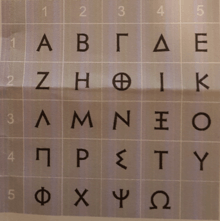Phryctoria
Phryctoria (Greek: φρυκτωρία) was a means of communication used in Ancient Greece.
Details
Phryctoriae were towers build on selected mountaintops so that one tower (phryctoria) would be visible to the next tower (usually 20 miles away). The towers were used for the transmission of a specific prearranged message. Flames were lit on one tower and then the next tower in succession also lit flames.
Aeschylus in the tragedy Agamemnon describe how the message for the fall of Troy arrived at Mycenae with phryctoriae.
Thucydides wrote how during the Peloponnesian War, the Peloponnesians who were in Corcyra informed at night by beacon signals of the approach of sixty Athenian vessels from Lefkada.[1]
Phryctoriae and Pyrseia

Ιn the 2nd century BC, the Greek engineers from Alexandria, Cleoxenes (Greek: Κλεόξενος) and Democletus (Greek: Δημόκλειτος) invented the pyrseia (Greek: πυρσεία). Πυρσεία from πυρσός which means torch. The letters of the Greek alphabet were listed on a table. Each letter corresponded to a row and a column on the table. By using two groups of torches (five torches in every group), the left indicating the row and the right the column of the table, they could send a message by defining a specific letter through combination of light torches.
The coding system was as follows:
| 1 | 2 | 3 | 4 | 5 | |
|---|---|---|---|---|---|
| 1 | Α | Β | Γ | Δ | Ε |
| 2 | Ζ | Η | Θ | Ι | Κ |
| 3 | Λ | Μ | Ν | Ξ | Ο |
| 4 | Π | Ρ | Σ | Τ | Υ |
| 5 | Φ | Χ | Ψ | Ω |
When they wanted to send the letter O (omicron), they fired five torches on the right set and three torches on the left set (see Polybius square).